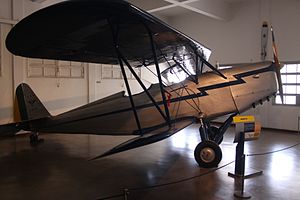The Muniz M-7 was a two-seat primary training biplane with tandem open cockpit and powered by a 130 hp (197 kW) de Havilland Gipsy Major engine. Designed by Lieutenant-Colonel Antonio Muniz, a serving officer in the Brazilian Air Force, as a primary trainer.[1] It was the first production aircraft designed in Brazil.[2] The M-7 prototype was built at the Central Aeronautics Park (Afonsos Air Force Base) and was first flown in October 1935. Production aircraft were built by Companhia Nacional de Navegação Aérea (CNNA) at Viana Island, (Rio de Janeiro). 11 aircraft were flown from 1937–1941 by the Military Aviation School based in Campo dos Afonsos, with the remaining 17 aircraft being sent to flying clubs.[3][2]
| Muniz M-7 | |
|---|---|

| |
| Role | Primary trainer |
| National origin | Brazil |
| Manufacturer | Companhia Nacional de Navegação Aérea (CNNA) |
| Designer | Antônio Muniz |
| First flight | 1935 |
| Primary user | Brazilian Air Force |
| Number built | 28 |
Operators
editSpecifications (M-7)
editData from Jane's All the World's Aircraft 1938[4]
General characteristics
- Crew: 2
- Length: 7.24 m (23 ft 9 in)
- Wingspan: 9.00 m (29 ft 6 in)
- Height: 2.85 m (9 ft 4 in)
- Wing area: 20.1 m2 (216 sq ft)
- Empty weight: 560 kg (1,235 lb)
- Gross weight: 860 kg (1,896 lb)
- Powerplant: 1 × de Havilland Gipsy Major , 97 kW (130 hp)
Performance
- Maximum speed: 190 km/h (120 mph, 100 kn)
- Cruise speed: 150 km/h (93 mph, 81 kn)
- Endurance: 5 hours
- Service ceiling: 4,000 m (13,100 ft) (absolute ceiling 5,200 m (17,100 ft))
See also
editRelated development
Related lists
References
edit- ^ "Muniz M-7 / M-9".
- ^ a b "Muniz M7 | Fábrica Brasileira de Aviões - MUSAL".
- ^ "7 Muniz M-7". Archived from the original on 2016-12-20.
- ^ Grey & Bridgman 1938, p. 12c
- Grey, C. G.; Bridgman, Leonard (1938). Jane's All the World's Aircraft 1938. London: Sampson Low, Marston & Company, Ltd.
- Taylor, Michael J. H. (1989). Jane's Encyclopedia of Aviation. London: Studio Editions.
- The Illustrated Encyclopedia of Aircraft (Part Work 1982-1985). Orbis Publishing.